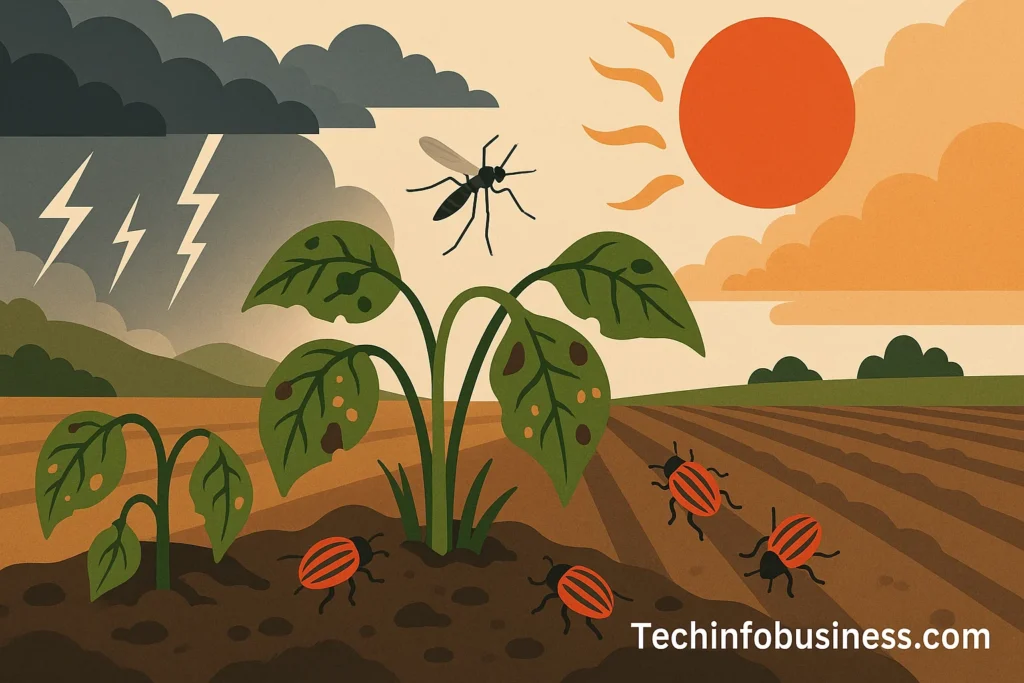Climate change is reshaping the environment where pests thrive, affecting their behavior, distribution, and impact. You may notice that some pests are becoming more common or expanding into areas where they were previously not seen, driven by shifting temperatures and changing weather patterns. Understanding how climate change influences pests is essential to managing their growing threats to your crops, health, and ecosystems.
You need to know that climate change directly affects insect pest populations by altering their life cycles, abundance, and geographical ranges, which can increase the challenges you face in controlling them. As pests adapt to new conditions, their seasons may lengthen, and their spread can accelerate, leading to more frequent infestations and the emergence of new pest species.
The complex relationship between climate change and pests means that many agricultural and natural systems are at risk, with pests responding in diverse ways depending on local environmental changes. Paying attention to these shifts will help you better anticipate pest risks and take proactive steps to protect your resources.
How Climate Change Influences Pest Behavior

Climate change affects pest behavior through multiple pathways, altering their growth rates, activity timing, and geographic range. These shifts alter how pests interact with your crops and environment, making traditional pest management strategies less effective.
Temperature Rise and Pest Growth
As temperatures rise, many pests experience accelerated development. Warmer conditions shorten their life cycles, so pests reproduce faster and increase their population density.
You may notice pests emerging earlier in the season or having more generations per year. This can intensify crop damage because pests spend more time feeding and breeding.
Temperature increases also expand the range of pests that couldn’t previously survive cooler climates. You should expect new pest challenges as species adapt to global warming, disrupting current agricultural pest control methods.
Changing Weather Patterns and Pest Emergence
Unpredictable weather and extreme events such as heatwaves or heavy rains influence when and how pests become active. Some pests adjust their feeding schedules, becoming more active during cooler parts of the day or exhibiting seasonal behavior changes.
Your pest monitoring needs to reflect these shifting patterns, as outbreaks may not follow historical timelines. Changes in humidity and rainfall also impact pest survival and reproduction, further complicating pest management under climate change.
Geographic Spread of Invasive Species
Climate change facilitates the expansion of invasive pests into regions where they were once absent. Warmer temperatures enable these species to establish in new environments, threatening your local ecosystems and crops.
You may encounter unfamiliar pests with no natural predators or effective control measures, which increases the risk to crop yields and biodiversity. Monitoring for invasive species and adapting your management strategies is essential as pests shift their geographic range due to climate change.
Impact on Household Pests and Mosquito Activity

Climate change influences how pests behave, reproduce, and spread, affecting your home and health. Warmer temperatures and shifting precipitation patterns enable pests, such as rodents and insects, to expand their range. Mosquito activity also adjusts to local climate shifts, altering risks in your area.
Household Pest Infestations in a Changing Climate
As temperatures increase, pests such as cockroaches, ants, and rodents find it easier to thrive year-round in your home and yard. Longer warm seasons extend their breeding periods and activity cycles, increasing the likelihood of infestations.
Humidity changes also affect pest survival. For example, bedbugs can proliferate in warmer, stable indoor environments, making control more difficult. Your household pest management needs to adapt to these evolving conditions by monitoring for longer infestations and practicing more frequent preventative measures.
Mosquitoes and Changing Weather Patterns in Dallas
In Dallas, fluctuating weather patterns caused by climate change affect how mosquitoes behave. Warmer winters enable more mosquitoes to survive throughout the season, while irregular rainfall increases breeding sites by creating additional stagnant water pools.
You may notice mosquito seasons starting earlier and lasting longer. These changes impact the local risk of vector-borne diseases such as West Nile virus. Staying aware of shifting mosquito activity in Dallas helps you protect yourself and your family from bites and associated health risks.
Household Mosquito Activity Climate Impact in Dallas
The Dallas area experiences shifts in mosquito activity due to increasing temperatures and altered rainfall patterns. Mosquitoes breed faster and in greater numbers when temperatures consistently remain above 70°F, which now occurs more frequently in spring and fall.
You might see mosquitoes outside your home nearly year-round, especially in shaded, moist areas. Managing standing water and using effective repellents becomes critical to limit mosquito attraction and potential disease transmission around your home in Dallas.
Climate Change Pest Control Strategies
Effective pest control strategies must account for shifting pest populations, changing pest behavior, and broader environmental impacts. This includes coordinated efforts at multiple levels—from community policies to industry innovations and practical preventative actions for homeowners.
Community and Policy Initiatives
Communities play a crucial role in managing pest outbreaks linked to climate change. Local governments can implement policies that promote sustainable land use and biodiversity, thereby reducing pest habitats and increasing natural pest predators.
Policies might include zoning regulations that limit monoculture farming, encouraging crop diversification to disrupt pest life cycles. Community education programs on climate change pest control strategies can raise awareness about early pest detection and reporting.
Key actions at the community level:
- Support integrated pest management (IPM) programs.
- Fund research on climate-adaptive pest control.
- Promote cooperation between farmers, researchers, and policymakers.
Such initiatives help create a proactive environment for combating pests whose ranges and breeding patterns are expanding due to warming temperatures.
Adaptation in Pest Management Industry
The pest management industry is evolving to handle the challenges posed by climate change and pests. Companies now utilize advanced monitoring technologies, such as remote sensing and predictive modeling, to anticipate pest outbreaks based on climate data trends.
Adapting chemical, biological, and physical control methods to new pest behaviors is essential. For instance, extended breeding seasons require more frequent monitoring and timely interventions to prevent population spikes.
Industry professionals also focus on climate-smart practices such as:
- Using environmentally safe pesticides.
- Enhancing biological controls by supporting natural predators.
- Developing resistant crop varieties in collaboration with agronomists.
These adaptive strategies aim to maintain effective pest control while minimizing environmental impact, ensuring crop protection and food security despite shifting pest dynamics.
Preventative Measures for Homeowners
Homeowners can take simple yet effective steps to prevent wildlife and pest problems aggravated by climate change. Since pests may migrate into new areas, maintaining your property’s defenses is crucial.
Actions include sealing entry points, removing standing water to reduce breeding sites, and trimming vegetation near structures to deter pests such as rodents and insects.
You should also consider:
- Regular property inspections, especially after extreme weather.
- Using humane deterrents to discourage wildlife intrusion.
- Implementing landscape changes that reduce pest attractiveness.
Early prevention reduces the need for reactive pest control measures, which may be less effective in changing climates.
For professional help, contacting experts is wise. Critter Stop offers free inspections and specializes in humane wildlife and pest removal. They consistently earn stellar reviews for combining thorough work and respectful customer service. Contact Critter Stop at (214) 234-2616 to protect your property from wildlife and pest issues effectively.



